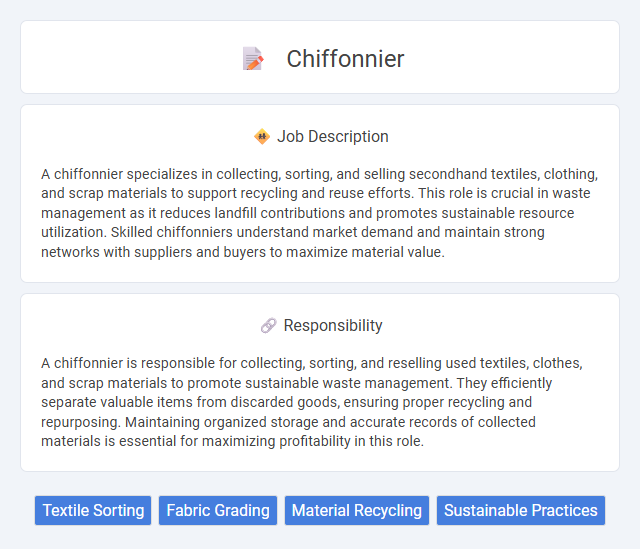
A chiffonnier specializes in collecting, sorting, and selling secondhand textiles, clothing, and scrap materials to support recycling and reuse efforts. This role is crucial in waste management as it reduces landfill contributions and promotes sustainable resource utilization. Skilled chiffonniers understand market demand and maintain strong networks with suppliers and buyers to maximize material value.
Chiffonnier work likely suits individuals who are comfortable with physically demanding and potentially unsanitary conditions, as the job involves scavenging and sorting through waste materials. People with high resilience, adaptability, and a tolerance for irregular hours may find this occupation more manageable. Those sensitive to environmental hazards or seeking stable, formal employment might face challenges thriving in this field.
Qualification
A chiffonnier typically requires strong organizational skills and attention to detail to manage and restore antique furniture effectively. Experience or training in woodworking, upholstery, or antiques appraisal is highly valuable for accurate identification and restoration work. Knowledge of historical furniture styles and materials enhances the ability to authenticate and preserve valuable pieces.
Responsibility
A chiffonnier is responsible for collecting, sorting, and reselling used textiles, clothes, and scrap materials to promote sustainable waste management. They efficiently separate valuable items from discarded goods, ensuring proper recycling and repurposing. Maintaining organized storage and accurate records of collected materials is essential for maximizing profitability in this role.
Benefit
A chiffonnier job likely offers the benefit of gaining hands-on experience in garment care and textile management, which can enhance skills valuable in the fashion and hospitality industries. This role may also provide opportunities for steady employment and the development of attention to detail, contributing to long-term career growth. Workers in this position might experience a supportive work environment with potential for flexible hours.
Challenge
The role of a chiffonnier likely involves navigating the challenge of sorting and repurposing discarded items efficiently in environments with unpredictable volume and variety. Managing the physical demands and maintaining motivation amid repetitive tasks could also pose significant difficulties. Successfully overcoming these obstacles may require strong organizational skills and resilience.
Career Advancement
A chiffonnier's career advancement typically involves gaining expertise in textile restoration, fabric appraisal, and antique furniture refurbishment, leading to roles such as senior restorer or conservator. Mastery of historical textile techniques and materials enhances opportunities for specialization in high-demand sectors like museum curation or luxury interior design. Continuous skill development and certification in preservation technologies are critical for progressing to supervisory or consultancy positions within heritage preservation organizations.
Key Terms
Textile Sorting
Chiffonniers specialize in textile sorting by carefully categorizing fabrics based on material, quality, and usability to maximize resource efficiency. Their expertise in distinguishing between natural and synthetic fibers ensures proper recycling or resale in the fashion and textile industries. Precision in sorting directly impacts supply chain sustainability by reducing waste and promoting circular economy practices.
Fabric Grading
Chiffonniers specializing in fabric grading expertly assess textile quality by categorizing materials based on thread count, weave type, and defect presence to ensure consistency in manufacturing. They apply industry standards and color matching techniques to classify fabric batches for optimal use in garment production and upholstery. Their keen attention to detail reduces waste and maximizes fabric utilization efficiency in supply chain processes.
Material Recycling
A chiffonnier specializes in collecting and sorting discarded textiles, metals, paper, and other recyclable materials from urban waste streams to facilitate material recycling. This occupation plays a crucial role in reducing landfill use by diverting valuable resources back into manufacturing processes, supporting circular economy initiatives. Expertise in identifying reusable materials ensures high recovery rates and promotes environmental sustainability through efficient waste management.
Sustainable Practices
Chiffonniers contribute to sustainable practices by collecting and sorting recyclable materials, reducing landfill waste and promoting circular economy principles. Their work supports resource recovery and minimizes environmental impact by diverting valuable materials from traditional waste streams. Efficient sorting and resale of goods also help decrease demand for new production, conserving energy and raw resources.
 kuljobs.com
kuljobs.com